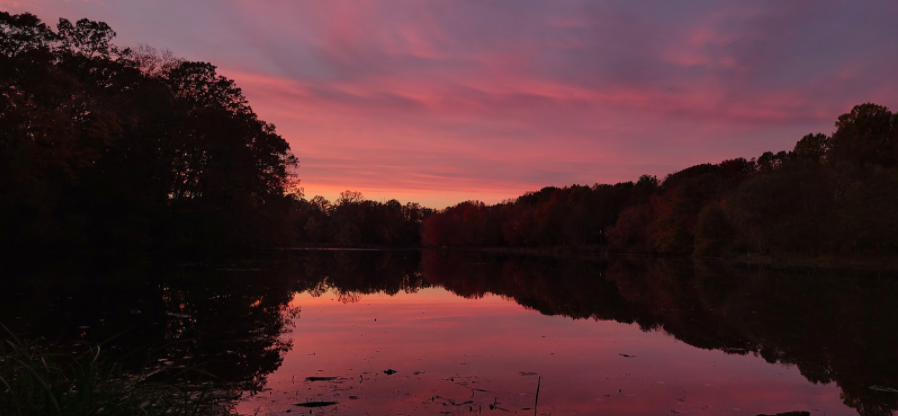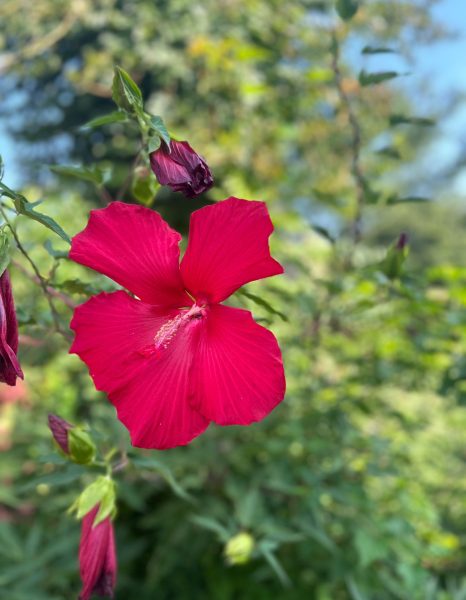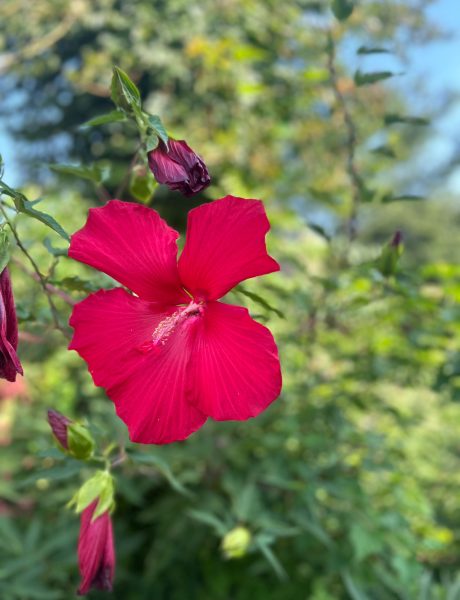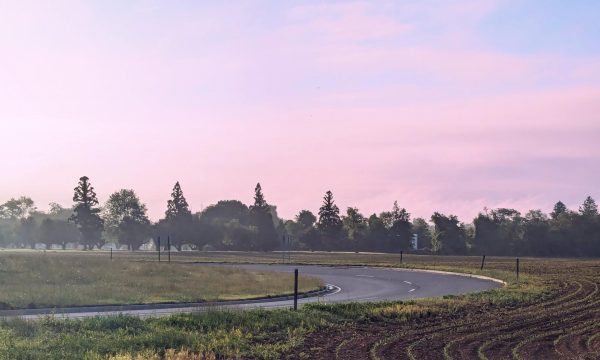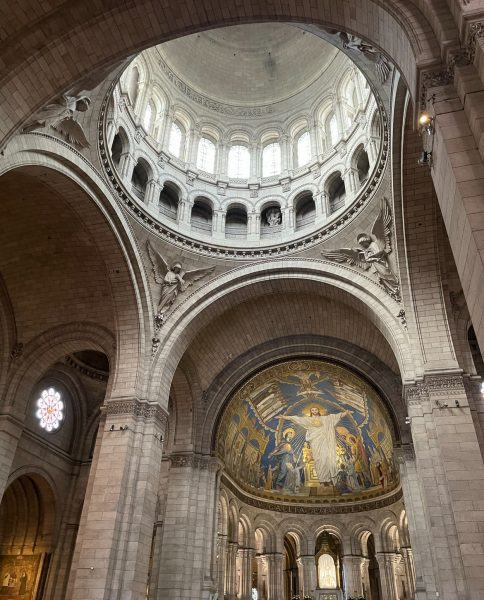Waterfowl of a Local Lake
I – The Autumnal Setting & Some Waterfowl
Again, I biked to those same local woods in the late afternoon. The sun was somewhat low in the sky but still higher than the treetops. Fallen leaves covered the forest floor completely and some trees were already bare. I biked down a slope to reach a trail that ran parallel along the banks of the nearby lake. Between the trail and the lake was a thin wall of trees and some low bushes of vine-like, thorn plants and Skunk Cabbage. The air was chilly that day, and the coldness made my breath feel cold too, especially when I inhaled. I neared a treeless clearing of land, which protruded a bit into the lake. I laid my bike down and sat on a seat-like, natural object facing the lake. There was an occasional cold breeze, and there I was, sitting and observing the view in front of me.
A flock or two of mallard ducks swam along the surface of the lake to my left. I saw a figure of a bird that looked to belong to the family Ardeidae (sizable wading birds), and if not, at least of the order Pelecaniformes (sizable water birds with webbed feet). Upon a closer look, I identified the figure to be that of a great blue heron. The flock of ducks took off noisily into the air, quacking as they did. The calm waters of the lake reflected the lakeside trees perfectly, along with their colorful canopies.
I am on the banks of a small lake, mostly surrounded by a forested area, of which I wrote about earlier. The air is cool and, from time to time, there is a soft, light breeze. The sky is mostly clear, save for a few wispy (cirrus) clouds. Almost all of the trees are exhibiting their autumnal colors, notably yellow, light red, and some orange. The sun is low, as it is late afternoon in the late fall of the Northern Hemisphere. Today, I saw a flock or two of mallard ducks swimming on the lake before departing into the air. Across the lake from me, I see a great blue heron standing near the water’s edge.
The water is somewhat cold, enough so as to warrant one to want to dry off quickly. The water, though clear to an extent, is very reflective, and I’d say that the scene is lovely. Under the surface, there is brown– even the coontails (an aquatic plant) don’t look as green as they did in the summer. On the water’s surface, hugging some of the banks of the lake, are a few small groups of tiny, light-green duckweed. The lily pads, which once extended to the surface or even higher, have now submerged. The section of the lake bottom visible from the banks is covered by plants, fallen leaves, and twigs, most of which are coated by a thin layer of brown sediment. Somewhere in the trees across the lake, I hear the caws and warbles of a blue jay. The caws of the blue jay sound similar to a crow’s, which is not surprising as both birds belong to the Corvidae family.
As the sun lowers, the air feels less warm. There was a great frost the previous night, judging by its presence in the morning. The yellow rays of the sun peak through the foliage, producing beautiful autumnal visuals. The floor of the forest behind me, just as the lake’s bottom in front, is covered by fallen leaves. As the evening nears, I begin to hear the chirp of a cricket and of a chipmunk behind me. A squirrel scampers on the trees and ground and gnaws audibly on a nut, and I can hear his other raucous rodent friends in the woods. I hear Canada geese honking on my left– two slide onto the water, then they are followed by three more. A V-shaped flock of geese flies from 3 o’clock, over the trees and across the lake.
At this point in time, it’s cold enough that I can see my breath. There are no more visible clouds in the sky– only a “haze” on the entire horizon. A lone goose flies above me, and is shortly followed by another flock, though the formation is more similar to a checkmark rather than a “V.” Some of the geese land on the lake, causing splashes as their feathered rears meet the water’s surface. A somewhat small bird– a mourning dove (based on the silhouette and sound of it)– flies diagonally across my field of vision, about 20 yards in front of me, heading towards my right. Across the lake, birds tweet short, one-off chirps multiple times. Then, there are two mourning doves, flying from my side of the lake to the opposite side.
There are no more rays of sun shining. The forest floor is much darker, but it is still visible due to the clear sky, which is a darker shade of light blue, now.
It is a curiosity that the late, autumnal, forested lake shows more signs of life at dusk than it did earlier in the day.
The next day, I returned to the same lakeside spot — this time, in the afternoon. There isn’t much of a breeze, and it feels noticeably warmer. The sky is covered by a layer of a semi-translucent cloud. The sun, its light, and rays were slightly hidden by the cloud layer, isn’t visually as bright as it was the day before. Crickets are chirping already, and a flock of mallard ducks in the lake quack from time to time. Upon closer observation, I count 16 of both genders; most of them have their heads turned back buried in their back feathers, and some have dipped their heads underwater, probably feeding on aquatic plant matter. I see the heron in the same place as yesterday. A flock of 17 Canada geese flies overhead and another of 12 flies from my left. Suddenly, one turns 180° and, a few seconds later, eight of the others follow. The honking sound of a goose heralds its entrance onto the lake, swimming towards the ducks in a shallow section of the middle of the water. Besides me, I watch minuscule, light-colored insects fly up and down, ones I cannot identify.
It is cold enough that I can see my breath, and it has gone dark, but still light enough to see. The clouds are catching a wider spectrum of colors: the clouds nearest to the setting sun are orange, pale pink, and pale purple and the furthest clouds are pink, magenta, and pink-red. A goose on my far left and the previous goose honk back and forth to each other. An unseen one comes into view and lands on the lake as the first one did. They continue honking. An aquatic, presumably cold-blooded animal just barely breaches the surface for an instant with a quiet splash– what it was, I could not determine. A few squirrels and chipmunks scamper about behind me– one rodent gnaws on an acorn and the other chips. The yellow leaves of trees are highlighted by the evening light.
As the sun lowers, the colors of the clouds and the illusions they perform with the sunbeams become more obvious; the clouds are now a deeper shade. A bird tweets a song behind me, and, to my left, a whole flock of geese land, honking onto the water, shortly followed by more waterbirds. Once again, it is audibly more lively in the late-autumnal evening. It doesn’t feel as cold as it did the day before, however. The woods behind me are dark, with very little light in them. Now, the clouds close to the sun are pink, purple, and blue while the clouds furthest from it are grey, a shade darker than the sky above them.
II – The Hunts Of A Heron
The heron is still across the lake from me– it’s moving, crouching its legs as it walks, intently directing its attention at something in the water. The bird stalks its target, its whole body (apart from the legs) near parallel above the lake’s surface, and shakes its head periodically. I am unsure whether it is doing so whilst swallowing food or not. Now, the heron has curled itself up to an almost ellipse-shaped “ball” and swings its head once again. It appears to be on its third attempt. The bird turns 180°, pauses, then turns 180° again. It seems to be on its fourth, or perhaps it had not finished its third try yet. The animal changes its posture to low crouching– it lunges but misses. Afterward, it shakes its head a bit again– ready to proceed with its fifth attempt. As a loud flock of geese land on the lake nearby, splashing as they do, I lose sight of the heron. I leave the lake for the day.
The next day, I returned to the same lakeside again. The bird is, once again, standing where I first saw it yesterday, in its upright stance where its legs are perpendicular to the lake’s surface. It’s stalking something again, crouching in a shape parallel to the water. The bird’s colorful features are greatly vibrant and clear in this posture. Soon, I lose sight of it.
Almost half an hour after losing the heron, I find it flying along the water on the opposite side of the lake. It returns to where I first saw it today, and a goose lands on the lake, and, once again, I lose the bird. Moments later, I noticed it again, but only for a short while. The heron’s wings flap carefully, parallel to the water, as it lands behind a tree far away on the lake’s edge.
The sun sets and the sky becomes darker. Though the scene sounds much more lively than it did before, I am not able to see the heron again that day. And so, I return home for the day.
Animals mentioned:
- Mallard Ducks
Mallard ducks are a common species of waterfowl (more specifically, duck) that are found in inland, central New Jersey. The adult males have a shiny, deep-green head, a yellow bill (beak), and a thin, white-colored “ring” around their necks. Their bodies tend to be a slightly lighter, less mottled, light-brown color, and lighter on their underside, and their rears are white. The females have a mottled (light) brown body, but a brown generally darker in shade than that of the males. On the tips of a female’s wings is a patch of darker brown feathers. Both genders have a light blue, small, rectangular patch of feathers on the outer edges underneath their wings. The underside of a mallard duck’s wings looks white. This species of duck tends to be quite “talkative” and feed on aquatic plant matter.
- Great Blue Herons
Great blue herons are one of the most common heron species seen in this NJ area. Generally, they have upside-down, teardrop-shaped bodies (when standing upright) and yellow, long, skinny necks. Their bodies are often light, blue-grey color and their wings are a darker tone. These herons have dark-colored plumes above their eyes, which reach to the back of their head and look similar to eyebrows. They have long, stilt-like legs, and their flexible necks tend to be a darker shade of their bodies, but are, generally, a lighter shade than their wings. The great blue heron’s squawks are loud and hoarse, and, unlike the mallard ducks, tend to fly silently.
- Canada Geese
Canada geese have brown bodies, generally darker on top and lighter on the bottom. They have black-colored necks, heads, eyes, and beaks (bills). Their bills are a bit more narrow than that of a mallard duck’s. Canada geese have a white-colored, rounded, chinstrap pattern on their cheeks. The rear hind of a goose is near-white and its chest is a lighter shade of its body. These geese have dark-colored webbed feet, which are much larger than the mallard ducks’. Their squawking honks are very notable; they tend to sound like it echoes, sometimes. When migrating, the geese prefer to fly in a V-shaped formation.

